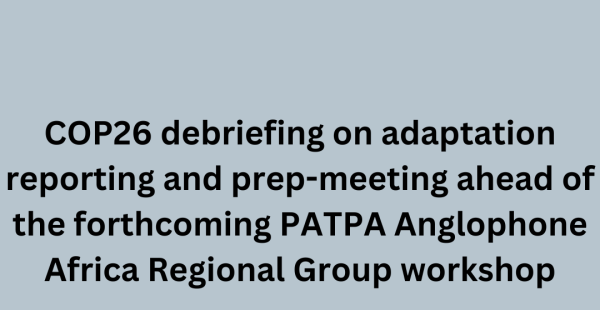
COP26 debriefing on adaptation reporting and prep-meeting ahead of the forthcoming PATPA Anglophone Africa Regional Group workshop
The Secretariat of the Partnership on Transparency in the Paris Agreement (PATPA) has organized on Wednesday, 1st of December 2021 a COP26 debriefing on the latest developments on adaptation reporting and a prep-meeting ahead of the forthcoming 2022 PATPA Anglophone African Regional Group workshop.
The objectives of this event were to:
- Share with participants the latest developments on adaptation reporting at COP26 and beyond
- Prepare for PATPA’s reporting on adaptation workshop in early 2022
34 participants from 10 countries and 6 international organisations participated in this remote event.
The workshop was facilitated by representatives of the PATPA Secretariat. Opening remarks were given by Sandra Motshwanedi from the Department of Forestry, Fisheries and the Environment (DFFE) in South Africa and a presentation on the latest developments on adaptation reporting was delivered by Timo Leiter, doctoral researcher at the Grantham Research Institute on Climate Change and the Environment of the London School of Economics and Political Science (LSE).
Many reporting vehicles (= reporting documents) are available for countries to report on adaptation: Adaptation Communications (ADCOM); National Communications (NC), National Adaptation Plans (NAP), Biennial Transparency Reports (BTR), Nationally Determined Contributions (NDC), Domestic Progress Reports.
Countries can choose any or several of these reporting documents depending on their capacity and the support available to them and the linkage to other policy processes. While there may be overlaps between those documents, each can contain different types of information due to their different purposes and the different frequency of reporting. Typically, countries have reported their vulnerabilities in their National Communications, but not the actions that have been or that will be undertaken. In turn, NAPs are very detailed planning documents including targets and actions, and NDCs are more useful to state the general commitments on adaptation only.
State of adaptation reporting. By November 2021, ten African countries submitted National Adaptation “Plans” (sometimes called “strategies”). Four were submitted via adaptation communications and six via NDCs. Several countries have a NAP but have not submitted it to the UNFCCC. In total, 34 adaptation communications were reported worldwide, including 19 as stand alone, 15 as part of NDCs, one as part of a National Communication and one as part of a NAP. BTRs are due by the end of 2024. BTRs are compulsory for high-income countries but LDCs and SIDS can submit them at their discretion. 70 Countries have NAP-type policies, and 129 out of 154 countries have begun the NAP process.
State of adaptation Monitoring & Evaluation. Progress on adaptation can be monitored and evaluated through national adaptation M&E systems, which inform domestic and international reporting. M&E systems differ widely between countries and should be tailored to national circumstances. There are no blueprints, but guidance is available. Since 2017, the number of countries engaged in developing or applying mechanism to track NAP implementation has increased by 40%, but 60% of countries that adopted a NAP are still not tracking its implementation. All developing countries which have engaged in a NAP M&E system have received support from development partners, but to different degrees depending on countries’ needs.
COP26 and beyond. To support reporting and M&E, COP26 adopted the Glasgow-Sharm el-Sheikh work programme for the Global Goal on Adaptation. This work programme will improve assessment of progress toward the adaptation goal and enable its implementation through regular workshops and work on methodologies to assess progress. One of the objectives of the programme is to “enhance understanding of how communication and reporting instruments established under the Convention and the Paris Agreement related to adaptation can complement each other in order to avoid duplication of efforts”
Information provided by countries in their M&E systems will be the primary inputs to assess global progress of adaptation under the Global Stocktake of the Paris Agreement. In this way, adaptation M&E also provides the information to fulfil international reporting requirements. The first Global Stocktake will be completed by 2023 (COP28).
PATPA will organize a workshop on the topics of adaptation reporting in early 2022 for its Anglophone African Regional Group. Participants indicated that they would most like to discuss “How information and data collection for M&E of adaptation can feed into the reporting processes” and the “different adaptation reporting vehicles". The exact dates, agenda and the invitation policy will be published here soon.
On the right margin of this webpage you find Timo Leiter's presentation on the latest developments on adaptation reporting and PATPA's slide deck with further information on the upcoming workshop on adaptation reporting for the Anglophone African Regional Group.

